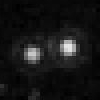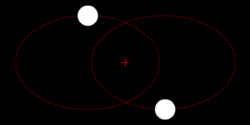Astronomy:66652 Borasisi
 Borasisi and its companion Pabu imaged by the Hubble Space Telescope in 2003 | |
| Discovery | |
|---|---|
| Discovered by | A. Trujillo, J. Luu and D. Jewitt |
| Discovery date | 8 September 1999 |
| Designations | |
| (66652) Borasisi | |
| Pronunciation | /bɒrəˈsiːsi/ |
| 1999 RZ253 | |
| Minor planet category | trans-Neptunian object cubewano[1][2] SCATNEAR(?)[3] |
| Orbital characteristics[5] | |
| Epoch 13 January 2016 (JD 2457400.5) | |
| Uncertainty parameter 3 | |
| Observation arc | 4790 days (13.11 yr) |
| |{{{apsis}}}|helion}} | 47.291 astronomical unit|AU (7.0746 Tm) |
| |{{{apsis}}}|helion}} | 39.819 AU (5.9568 Tm) |
| 43.555 AU (6.5157 Tm) | |
| Eccentricity | 0.085781 |
| Orbital period | 287.45 yr (104991 d) |
| Mean anomaly | 60.025° |
| Mean motion | 0.0034289°/day |
| Inclination | 0.56319° |
| Longitude of ascending node | 84.722° |
| 194.98° | |
| Known satellites | Pabu /ˈpɑːbuː/ (137 km in diameter?)[4] |
| Physical characteristics | |
| Mean diameter | 163+33 −66 km (combined) 126+25 −51 km (primary) 105+20 −42 km (secondary)[6] |
| Mass | (3.433±0.027)×1018 kg[7] |
| Mean density | 2.1+2.6 −1.2 g/cm3[6] |
| Rotation period | 6.4±1.0 h[6] |
| Geometric albedo | 0.236+0.438 −0.77[6] |
| V−R= 0.646 ± 0.058[6] | |
| Absolute magnitude (H) | 6.121 ± 0.070,[6] 5.9[5] |
66652 Borasisi, or as a binary (66652) Borasisi-Pabu,[7] is a binary classical Kuiper belt object. It was discovered in September 1999 by Chad Trujillo, Jane X. Luu and David C. Jewitt[5] and identified as a binary in 2003 by K. Noll and colleagues[5] using the Hubble Space Telescope.
Binary
In 2003 it was discovered that 66652 Borasisi is a binary with the components of comparable size (about 100–130 km) orbiting the barycentre on a moderately elliptical orbit.[6][8] The total system mass is about 3.4 × 1018 kg.[7]
The companion (66652) Borasisi I, named Pabu, orbits its primary in 46.2888 ± 0.0018 days on an orbit with semi-major axis of 4528 ± 12 km and eccentricity 0.4700 ± 0.0018. The orbit is inclined with respect to the observer by about 54° meaning that is about 35° from the pole-on position.[7]
Physical properties
The surface of both components of the Borasisi–Pabu system is very red.[6]
Naming
Borasisi is named after a fictional creation deity taken from the novel Cat's Cradle by Kurt Vonnegut.[9] In the book, Borasisi is the Sun and Pabu is the name of the Moon:[10]
- Borasisi, the sun, held Pabu, the moon, in his arms and hoped that Pabu would bear him a fiery child. But poor Pabu gave birth to children that were cold, that did not burn... Then poor Pabu herself was cast away, and she went to live with her favorite child, which was Earth.
Exploration
Around 2005, Borasisi was considered as a target for the proposed New Horizons 2 after a Triton/Neptune flyby.[11]
References
- ↑ "MPEC 2009-R09 :Distant Minor Planets (2009 SEPT. 16.0 TT)". IAU Minor Planet Center. 2009-09-04. http://www.cfa.harvard.edu/mpec/K09/K09R09.html.
- ↑ (66652) Borasisi = 1999 RZ253 Orbit
- ↑ Marc W. Buie. "Orbit Fit and Astrometric record for 66652". SwRI (Space Science Department). http://www.boulder.swri.edu/~buie/kbo/astrom/66652.html.
- ↑ Wm. Robert Johnston (2008-11-25). "(66652) Borasisi". Johnston's Archive. http://www.johnstonsarchive.net/astro/astmoons/am-66652.html.
- ↑ 5.0 5.1 5.2 5.3 "JPL Small-Body Database Browser: 66652 Borasisi (1999 RZ253)". https://ssd.jpl.nasa.gov/sbdb.cgi?sstr=66652.
- ↑ 6.0 6.1 6.2 6.3 6.4 6.5 6.6 6.7 Vilenius, E. et al. (2014). ""TNOs are Cool": A survey of the trans-Neptunian region X. Analysis of classical Kuiper belt objects from Herschel and Spitzer observations". Astronomy & Astrophysics 564: A35. doi:10.1051/0004-6361/201322416. Bibcode: 2014A&A...564A..35V.
- ↑ 7.0 7.1 7.2 7.3 Grundy, W. M.; Noll, K. S.; Nimmo, F.; Roe, H. G.; Buie, M. W.; Porter, S. B.; Benecchi, S. D.; Stephens, D. C. et al. (2011). "Five new and three improved mutual orbits of transneptunian binaries". Icarus 213 (2): 678. doi:10.1016/j.icarus.2011.03.012. Bibcode: 2011Icar..213..678G. http://es.ucsc.edu/~fnimmo/website/Grundy_KBO.pdf.
- ↑ Keith S. Noll; Denise C. Stephens; Will M. Grundy; Ian Griffin (December 2004). "The orbit, mass, and albedo of transneptunian binary (66652) 1999 RZ253". Icarus 172 (2): 402–407. doi:10.1016/j.icarus.2004.06.009. Bibcode: 2004Icar..172..402N.
- ↑ Michael E. Brown, How I Killed Pluto and Why It Had It Coming. ch. 11 "Planet or Not"
- ↑ JPL Small-Body Database Browser
- ↑ Final Report of the New Horizons II Review Panel
External links
 |


